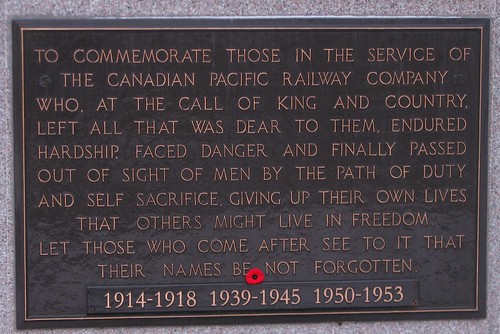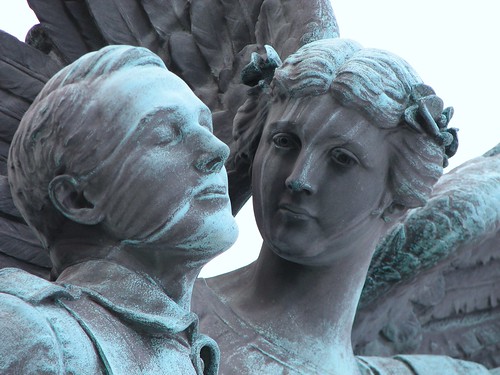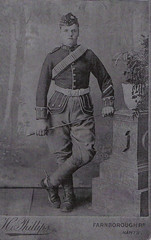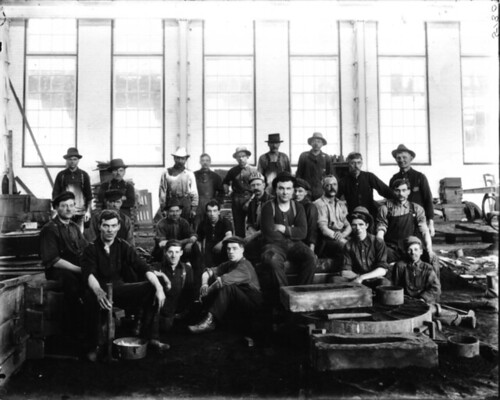William Harvey was born February 17, 1881 to Robert and Frances Harvey of # 4 Walton Street in Dundee, Scotland. After serving with the Gordon Highlanders in South Africa, Harvey decided to seek new adventures and immigrated to Canada in 1911, likely first arriving in Montréal.
Around that same time, Winnipeg was in the midst of unprecedented growth. Harvey, like many young immigrants at the time, found himself drawn to the ‘Chicago of the North’.
(Heritage Winnipeg Website, 04-437)
He went to work for the expanding Canadian Pacific Railway as a ‘craneman’ and ‘turntableman’ in 1912. There were two places he likely worked from. First, could be the cargo area at the rear of the CPR station on Higgins.
As a craneman he very likely worked at the WWI era “roundhouses” at the CPR Weston Shops.
Records indicate that he had no fixed address. That could mean that he lived at the CPR bunkhouses. Another explanation is that during the boom times of early Winnipeg it was not uncommon for people to have to live in makeshift, tent cities while waiting for new housing to be built to absorb them. Whatever the reason, he never settled into a permanent home, apartment or rooming house.
There was a grand Scottish social scene at the time that William would have been part of.
The Winnipeg Robbie Burns Society, the oldest chapter outside of the UK, was created in 1907 by a number of Scottish workers in the CPR shops. He certainly would have heard about the society, if he wasn’t an active participant.
The Scottish sports scene was also thriving. The 1915 the Winnipeg Scottish Football Club won the Canadian championship, (in 2004 they were inducted into the Manitoba Sports Hall of Fame for the feat). It’s likely that William would have taken in their games, maybe even played for them at times !
 Troops Leave From CPR Station, 1915
Troops Leave From CPR Station, 1915“Off to war, 3,000 in one day”
(from Manitobia Life and Times website)
Given his military background, it is no surprise that William became a member of the 79th Cameron Highlanders militia. On October 10, 1914 he enlisted with the 27th City of Winnipeg Battalion as a private.
William left Halifax N.S. for England on January 20th 1915 and on February 23rd 1915 went on to France. He was transferred in the field to 2 PPCLI and rose in rank to Lance Corporal. Within weeks the PPCLI would be involved in the battle of Bellewaerde Ridge, Belgium. The regimental war diary describes the battle of May 4, 1915 this way:
William left Halifax N.S. for England on January 20th 1915 and on February 23rd 1915 went on to France. He was transferred in the field to 2 PPCLI and rose in rank to Lance Corporal. Within weeks the PPCLI would be involved in the battle of Bellewaerde Ridge, Belgium. The regimental war diary describes the battle of May 4, 1915 this way:
“Heavy shelling continued through out the day. trenches in many places where blown in Nos 1& 2 coys in the fire line trenches lost heavily. 26 men killed 96 men wounded two of which died two days later”.

His body was never recovered, his official burial place is listed as the Menin Gate Memorial in Ypres.
Inscribed in the monument are the names of the 55,000 soldiers killed in the area, 6,940 of them Canadian. This is an excerpt of the text over one of the gates:
“To the armies of the British Empire who stood here from 1914 to 1918 and to those of their dead who have no known grave. Here are recorded names of officers and men who fell in Ypres Salient but to whom the fortune of war denied the known and honoured burial given to their comrades in death”
Each day at sunset the dead are remembered as traffic through the gateway is halted and two buglers sound the Last Post. The trumpets used were a gift by an officer of the Royal Canadian Artillery who fought there in 1915.


The Canadian Pacific Railway has a monument in Winnipeg dedicated to CPR men who fell in World War One, though it contains no names. In the 90’s it was moved from CPR property to the front lawn of Deer Lodge Centre and was rededicated to CPR men who fell in all wars.

Due to his brief time in Winnipeg and apparent transient situation, William Harvey was a man without a home town. An immigrant who came to make a new life, helped build the west, work in the poor conditions offered by the railway repair shops and gave his life without an obituary or other recognition that he was a Winnipegger.

Also see: My Flickr album for William Harvey
Update:
A scan of the May 5, 2008 obituary
A Soldier Remembered Winnipeg Free Press, Sept 14, 2008







No comments:
Post a Comment